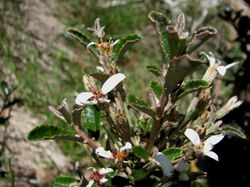Biology:Olearia myrsinoides
| Olearia myrsinoides | |
|---|---|

| |
| In the Alpine National Park | |
| Scientific classification | |
| Kingdom: | Plantae |
| Clade: | Tracheophytes |
| Clade: | Angiosperms |
| Clade: | Eudicots |
| Clade: | Asterids |
| Order: | Asterales |
| Family: | Asteraceae |
| Genus: | Olearia |
| Species: | O. myrsinoides
|
| Binomial name | |
| Olearia myrsinoides (Labill.) F.Muell. ex Benth.[1]
| |
| Synonyms[1] | |
| |
Olearia myrsinoides, commonly known as silky daisy-bush[2] or blush daisy bush,[3] is a species of flowering plant in the family Asteraceae and is endemic to south-eastern Australia. It is a spreading shrub with hairy branchlets, egg-shaped to elliptic leaves with toothed edges, and white and yellow or mauve, daisy-like inflorescences.
Description
Olearia myrsinoides is a spreading shrub that typically grows to a height of 0.8–1.5 m (2 ft 7 in–4 ft 11 in), its branchlets covered with whitish hairs. The leaves are arranged alternately, egg-shaped with the narrower end towards the base, to elliptic, 4–30 mm (0.16–1.18 in) long and 3–22 mm (0.12–0.87 in) wide with toothed edges. The upper surface of the leaves is dark green and glabrous, the lower side covered with whitish hairs. The heads or daisy-like "flowers" are arranged in leafy panicles in leaf axils and on the ends of branches on a peduncle up to 32 mm (1.3 in) long. The heads are 13–21 mm (0.51–0.83 in) wide with a conical involucre 4–6 mm (0.16–0.24 in) long. Each head has two to four white ray florets, the ligule 6–8 mm (0.24–0.31 in) long, surrounding three or four yellow or mauve disc florets. Flowering occurs from March to November and the fruit is a glabrous achene, the pappus 5–8 mm (0.20–0.31 in) long.[2][3][4]
Taxonomy
Silky daisy-bush was first formally described in 1806 by Jacques Labillardière, who gave it the name Aster myrsinoides in his Novae Hollandiae Plantarum Specimen.[5][6] In 1867, George Bentham changed the name to Olearia myrsinoides in Flora Australiensis.[7]
Distribution and habitat
Olearia myrsinoides grows in forest, woodland, grassland, and swampy areas in eastern New South Wales, southern Victoria and Tasmania.[2][8][9]
References
- ↑ 1.0 1.1 "Olearia myrsinoides". https://biodiversity.org.au/nsl/services/apc-format/display/105141. Retrieved 8 June 2022.
- ↑ 2.0 2.1 2.2 Walsh, Neville G.; Lander, Nicholas S.. "Olearia myrsinoides". Royal Botanic Gardens Victoria. https://vicflora.rbg.vic.gov.au/flora/taxon/7cee4e47-1df2-43c2-af17-941fd09f0dcf.
- ↑ 3.0 3.1 Lander, Nicholas S.. "Olearia myrsinoides". Royal Botanic Garden Sydney. https://plantnet.rbgsyd.nsw.gov.au/cgi-bin/NSWfl.pl?page=nswfl&lvl=sp&name=Olearia~myrsinoides.
- ↑ Fairley, Alan (1989). Native plants of the Sydney district : an identification guide. Kenthurst: Kangaroo Press in association with the Society for Growing Australian Plants-NSW. p. 310. ISBN 0864172613.
- ↑ "Aster myrsinoides". https://biodiversity.org.au/nsl/services/rest/name/apni/537813/api/apni-format. Retrieved 8 June 2022.
- ↑ Labillardière, Jacques (1806). Novae Hollandiae Plantarum Specimen. 2. Paris. p. 53. https://www.biodiversitylibrary.org/item/127076#page/53/mode/1up. Retrieved 8 June 2022.
- ↑ "Olearia myrsinoides". https://biodiversity.org.au/nsl/services/rest/name/apni/534502/api/apni-format. Retrieved 8 June 2022.
- ↑ Jordan, Greg. "Olearia myrsinoides". University of Tasmania. https://www.utas.edu.au/dicotkey/dicotkey/AST/ast/sOlearia_myrsinoides.htm.
- ↑ Wood, Betty. "Olearia myrsinoides". Lucid Keys. https://apps.lucidcentral.org/plants_se_nsw/text/entities/olearia_myrsinoides.htm.
Wikidata ☰ Q7086003 entry
 |

